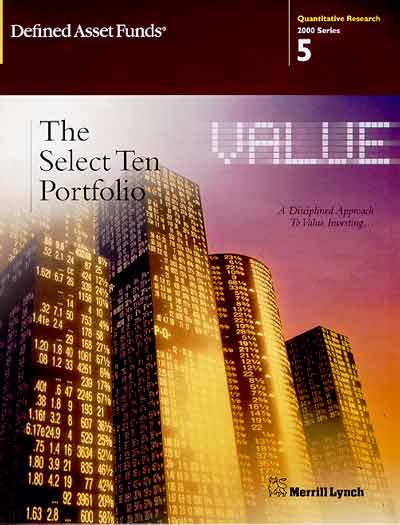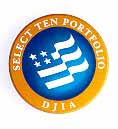|
|
|
|
|
Previous: DAVIS PARK SERIES TRUST, 485APOS, 2000-12-19 |
Next: FT 483, 497J, 2000-12-19 |
 |
 |
THE
DOW JONES INDUSTRIAL AVERAGE* (DJIA) — Its
30 companies are known the world over as giants of global industry. A benchmark
for American stock prices, its gains and losses influence markets around
the globe. Defined Asset Funds® offers you a strategy designed
to select value stocks from this esteemed index with our...
Select Ten Strategy |
|
| Defined
Asset Funds —
Our Philosophy At Defined Asset Funds, we believe that knowledge and discipline are essential to sound investment planning. For this reason, our unit investment trusts provide the information to help you invest appropriately, and the discipline to help you stay on course. We've found that diversity and drive can be key to uncovering compelling investments. To this end, our experienced team of research analysts and securities traders searches Wall Street and beyond, creating portfolios for strong potential. Our equity funds seek to capitalize on vibrant economic sectors, innovative quantitative strategies and thorough fundamental analysis. Our fixed-income funds offer the regular income and stability to help balance and diversify your investment assets. At Defined Asset Funds, we set the foundation for each of our portfolios in this way, because we have a very important goal in mind — yours. |
The
Portfolio
The Defined Asset Funds Select Ten Portfolio seeks total return by investing in ten stocks from the DJIA, based on dividend yield. The Portfolio aims for both dividend income and capital appreciation by following a value-oriented strategy. Dividend
Yield
The
Universe
|
New
Portfolio Annually
The Portfolio will hold its stocks for about one year. At the end of that period, we intend to reapply the Strategy to select a new Portfolio of the ten highest dividend-yielding stocks at that time. This annual process makes it possible for the Strategy to capitalize on new opportunities in the marketplace. Although this is a one year investment, we recommend you stay with this Strategy for at least three to five years for potentially more consistent results. Discipline
Tax
Efficiency
|
|
Past Performance of Prior Select Ten Portfolios |
||||
| Past Performance is no guarantee of future results | ||||
|
|
|
|||
|
|
||||
|
|
|
|
|
|
|
|
|
|
|
|
|
|
|
|
|
|
|
|
|
|
|
|
|
|
|
|
|
|
|
|
|
|
|
|
|
|
|
|
|
|
|
|
|
|
|
|
|
|
|
|
|
|
|
|
|
|
|
|
| The chart above shows average annual total returns, which represent price changes plus dividends reinvested, divided by the initial public offering price, and reflects maximum sales charges and expenses. From Inception returns differ from Most Recently Completed Portfolio returns because the former figures reflect different performance periods and a reduced sales charge on annual rollovers. | |
| * | Dow Jones & Company, Inc., owner of the name "Dow Jones Industrial Average," is unaffiliated with, and did not participate in the creation of this Portfolio or the selection of its stocks, and has neither reviewed nor approved any information in this brochure or the prospectus relating to this Portfolio. "S&P 500 Index" is a trademark of The McGraw-Hill Companies, Inc. |
| Select Ten Industrial Portfolio 2000 Series 5† | |||
| Name of Issuer | Symbol |
|
|
|
|
Philip Morris Companies, Inc. | MO |
|
|
|
AT&T Corporation | T |
|
|
|
Eastman Kodak Company | EK |
|
|
|
General Motors Corporation | GM |
|
|
|
Caterpillar, Inc. | CAT |
|
|
|
Du Pont (E.I.) De Nemours & Company | DD |
|
|
|
J.P. Morgan & Company, Inc. | JPM |
|
|
|
International Paper Company | IP |
|
|
|
Minnesota Mining & Manufacturing Company | MMM |
|
|
|
Exxon Mobil Corporation | XOM |
|
|
The Portfolio does not reflect the research opinions or any buy or sell recommendations of any of the Sponsors. |
|||
|
Hypothetical Past Performance of the Strategy (not any Portfolio) 27-Year Annual Total Returns Strategy returns are net of sales charges and expenses.§ |
|||||||
| Year | Strategy§ | DJIA | S&P 500*
Index |
Year | Strategy§ | DJIA | S&P
500 Index |
| 1973 | -4.08% | -13.12% | -14.66% | 1988 | 22.44 | 15.95 | 16.58 |
| 1974 | -2.40 | -23.14 | -26.47 | 1989 | 25.65 | 31.71 | 31.11 |
| 1975 | 55.65 | 44.40 | 36.92 | 1990 | -10.14 | -0.57 | -3.20 |
| 1976 | 33.25 | 22.72 | 23.53 | 1991 | 31.81 | 23.93 | 30.51 |
| 1977 | -2.90 | -12.71 | -7.19 | 1992 | 6.44 | 7.34 | 7.67 |
| 1978 | -1.91 | 2.69 | 6.39 | 1993 | 25.30 | 16.72 | 9.97 |
| 1979 | 10.48 | 10.52 | 18.02 | 1994 | 1.95 | 4.95 | 1.30 |
| 1980 | 24.69 | 21.41 | 31.50 | 1995 | 34.97 | 36.48 | 37.10 |
| 1981 | 5.51 | -3.40 | -4.83 | 1996 | 26.34 | 28.57 | 22.69 |
| 1982 | 23.78 | 25.79 | 20.26 | 1997 | 19.92 | 24.78 | 33.10 |
| 1983 | 36.93 | 25.68 | 22.27 | 1998 | 8.55 | 18.00 | 28.34 |
| 1984 | 5.41 | 1.06 | 5.95 | 1999 | 1.68 | 27.01 | 20.89 |
| 1985 | 27.00 | 32.78 | 31.43 |
9/30/00
|
-9.92 | -6.28 | -1.39 |
| 1986 | 32.96 | 26.91 | 18.37 | ||||
| 1987 | 5.06 | 6.02 | 5.67 |
Average
|
14.51% | 13.02% | 13.23% |
| Average Annual
Total Returns
|
||||||||
| For periods ending 12/31/99 |
|
|
|
|
|
|
||
| Strategy§ | 9.49% | 17.51% | 13.65% | 16.47% | 17.01% | 16.99% | ||
| DJIA | 23.20% | 26.83% | 18.19% | 19.52% | 17.95% | 16.72% | ||
| S&P 500 Index | 27.34% | 28.28% | 18.07% | 18.78% | 17.64% | 17.02% | ||
|
Hypothetical past performance of the Strategy is no guarantee of future performance of any Portfolio. There can be no assurance that any Portfolio will outperform either index. The Strategy would have underperformed the DJIA in 14 and the S&P 500 Index in 13 of the last 27 years. Returns shown represent price changes plus dividends reinvested at year ends, divided by the initial public offering price, and do not reflect deduction of any commissions or taxes. Portfolio performance will differ from the Strategy because Portfolios are established and liquidated at different times during the year, they normally purchase and sell stocks at prices different from those used in determining Portfolio unit price, they are not fully invested at all times, stocks may not be weighted equally and Strategy returns do not reflect deduction of commissions. |
||||||||
| The Dow Jones
Industrial Average
The Dow Jones Industrial Average consists of 30 common stocks chosen by the editors of The Wall Street Journal. The current companies are: Alcoa
|
| † | Initial date of deposit December 4, 2000. |
| ‡ | Current dividend yield for each security was calculated by annualizing the last monthly, quarterly or semi- annual ordinary dividend declared on that security and dividing the result by its market value as of the close of trading on October 10, 2000. There can be no assurance that future dividends, if any, will be maintained at the indicated rates. |
| § | Net of Portfolio sales charges (2.50% for the first year, 1.50% for each subsequent year), creation and development fee and estimated expenses. |
 |
| QUANTITATIVE RESEARCH
& INDEX
Institutional Holdings Portfolio S&P Market Cap Plus Portfolio S&P 500 Trust S&P MidCap Trust Select S&P Industrial Portfolio Select Growth Portfolio Select Large-Cap Growth Portfolio Select Ten Portfolio (DJIA) Standard & Poor's Industry Turnaround Portfolio Standard & Poor's Intrinsic Value Portfolio United Kingdom Portfolio (Financial Times Index) SECTOR
FUNDAMENTAL RESEARCH
FIXED INCOME
|
| Defining
Your Risks
Please keep in mind the following factors when considering this investment. Your financial professional will be happy to answer any questions you may have. |
||
|
||
|
Taxes Generally, dividends and any net capital gains will be subject to tax each year, whether or not reinvested. Please consult your tax advisor concerning state and local taxation. |
||
|
Defining Your Costs You will pay an initial sales
charge of about 1% the first time you buy. In addition, you'll pay a deferred
sales charge of $15.00 per 1,000 units, about 1.50%.
|
||||
| Unitholder Fees | Maximum
as a %
of the Amount Invested |
|||
|
|
||||
| Creation and Development Fee
(0.250% of net assets) |
0.30% | |||
| Sales Charges | 2.50% | |||
|
|
||||
| Total Maximum Sales Charges
(including creation and development fees) |
2.80% | |||
|
|
||||
| If you sell your units before the termination
date, any remaining balance of your deferred sales charge will be deducted,
along with the estimated costs of selling Portfolio securities, from the
proceeds you receive. If you roll over to a successor Portfolio, if available,
the initial sales charge on that Portfolio will be waived. You will only
pay the deferred sales charge.
|
||||
| Portfolio Expenses | Amount per 1,000 Units | |||
| Estimated Annual Operating Expenses
(0.174% of net assets) |
$1.72 | |||
| Estimated Organization Costs | $0.92 | |||
|
|
||||
| Volume Purchase Discounts
For larger purchases, the overall sales charges are reduced to put more of your investment dollars to work for you. |
||||
| If You
Invest: |
Your
Maximum Sales Charge
(as a % of your investment) Will Be: |
||
|
|
|||
| Less than $50,000 | 2.50% | ||
| $50,000 to $99,999 | 2.25 | ||
| $100,000 to $249,999 | 1.75 | ||
| $250,000 to $999,999 | 1.50 | ||
| $1,000,000 or more | 0.75 | ||
|
|
|||
| Add Value To Your Portfolio
Today!
You can get started with $250. This Fund is eligible for purchase through Unlimited AdvantageSM accounts, in which Unlimited Advantage fees apply in lieu of traditional sales charges. Call your financial professional to learn how the Select Ten Portfolio may help to meet your personal investment goals and how it may be appropriate for your IRA account. You may request a free prospectus containing more complete information, including sales charges, expenses and risks.You may also download a prospectus from our Web site address listed above. Please read it carefully before you invest or send money. The information in this brochure is not complete and may be changed. We may not sell the securities of the next Portfolio until the registration statement filed with the Securities and Exchange Commission is effective. This brochure is not an offer to sell these securities and is not soliciting an offer to buy these securities in any state where their offer or sale is not permitted. |
 |
Printed on Recycled Paper |
11342BR-12/00 |
|
© 2000 Merrill Lynch, Pierce, Fenner & Smith Incorporated. Member SIPC. Defined Asset Funds is a registered service mark of Merrill Lynch & Co., Inc. |
|
|